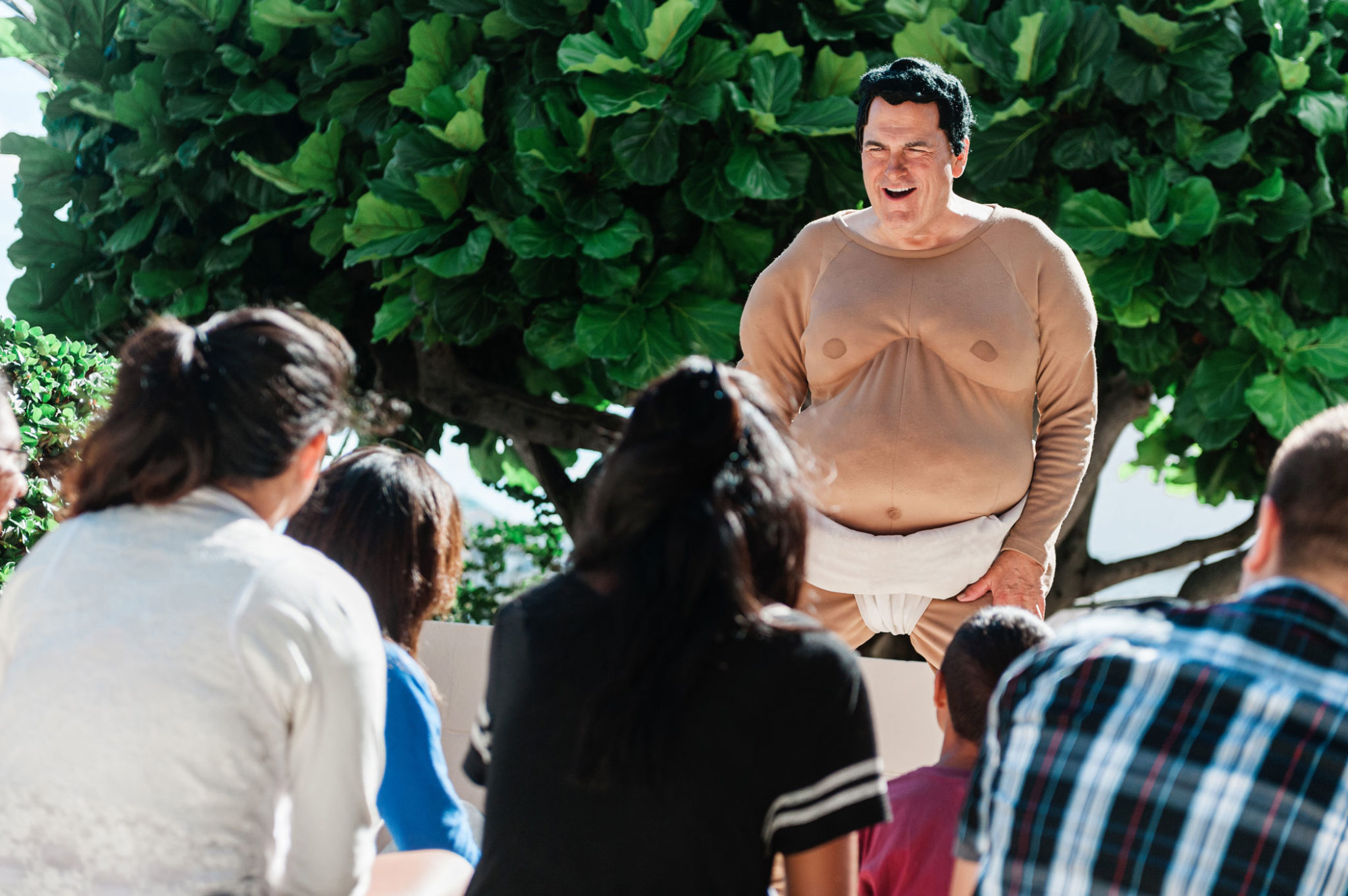Images by John Hook
Frank De Lima, holding a packet of Stevia in one hand and a glass of water in the other, sits in a well-lit corner booth at Zippy’s Makiki. He takes a sip from his cup and places it adjacent to the chipped blue and white plate before him, where two slices of wheat toast sit, dry and plain. Then, he gently tears a corner of the Stevia packet and sprinkles the crystals about the bread, turning every inch of its surface white.
It’s a curious sight. When performed by Hawai‘i’s most beloved living comedian, it feels like the start of a drawn-out setup, a gag eagerly awaiting a punch line. After he delicately lifts the toast to his lips, you expect De Lima to break out into one of his famous caricatures, like Imelda Marcos, incredulous at what she’s about to eat, or a member of Haoles Anonymous, who’s about to genuinely enjoy it.
Instead, what De Lima delivers is a little bit of both with a self-deprecating smile, aware that in a local diner, where the menu is bloated with clubhouse sandwiches and chicken katsu curry, his order does indeed look like a joke. “I have to watch my health,” he says, proceeding to chew with an inflated expression of delight, like someone who’s making the best of an otherwise unsavory situation. He dusts a crystalline granule from his black polo shirt, which is emblazoned with what he considers these days to be his life’s work—the words “Frank De Lima’s Student Enrichment Program”—over his heart. For more than 35 years, De Lima has shouldered the unique task of making all of Hawai‘i’s keiki laugh and learn via the nonprofit organization, performing a comedy routine at state public and private schools that helps to ready Hawai‘i’s youth for academic success and aid them in taking responsibility for their futures.
De Lima himself came to this understanding at age 25, when he became ordained as a deacon in the Roman Catholic Church, before realizing his passion for comedy. It’s a narrative many students can relate to—of doing the expected versus listening to your calling. “Every day you need to prepare, because eventually your career is going to be right in front of you,” says De Lima, who himself admits to not always having the best grades in school. “I used to daydream all the time, and finally teachers started to guide me, and it ultimately helped me in my career. My work has two very important parts: one is to sit and daydream, the second is to gather all kine material—by reading, watching the news, commercials, just collecting all this information. You need to gather and prepare all your material, and then you create, whatever that may be.”
For those who remember De Lima visiting their cafeterias or auditoriums decades ago, the Student Enrichment Program today is fundamentally the same. “I still do the buta hunt and the peanut buttah and jelly,” he says of the two sing-alongs most adults remember him for. The former is a vivid play-by-play of encountering a wild boar in a Hawaiian forest; the latter, a step-by-step guide to making a peanut butter and jelly sandwich. “Let me tell you, ’til today, I get 40-year-old men coming up to me going, ‘Whoa, the buta hunt, that was so good!’ And I say, ‘That was kindergarten, first grade,’ and they say, ‘Yeah, I still remember! And my kids are coming home and doing it, and now we can as a family.’”

To De Lima, the delight of the schoolchildren for which he performs has remained constant. What has changed, however, is technology and popular culture. Trolling mainstream radio recently, De Lima retooled top-40 hits by Silentó and Meghan Trainor to discuss the importance of healthy nutrition. He sings an ode to Tennessee Titans player and Saint Louis School graduate Marcus Mariota to highlight why it’s crucial to stay focused and prepare for the future. He shares cautionary instructions about social networking and cyberbullying, two terms that didn’t even exist when he first launched his program in 1980.
Basically, De Lima communicates the same serious messages most teachers and guidance counselors already do—“stay in school, do your homework, listen to your parents and teachers”—but when performed in costume as a 350-pound sumo wrestler to the tune of “Watch Me (Whip/Nae Nae),” those missives don’t seem as overbearing. Instead, De Lima makes the subjects fun, or funny, rather, and as a result, has become something of Hawai‘i’s favorite substitute teacher.
Even for the current generation of kids who may not connect him with his classic sketches playing characters like Glenn Miyashiro or Titarella, De Lima remains relevant. “I introduce myself by saying, ‘Some of you don’t know who I am, but how about this?’” Then he raises his voice up a screeching octave. “Four-two-two, two-two, two-two. When I do that,” he says of his tutu character from those well-known The Cab commercials, “their eyes just light up. They know I’m the silly man on TV.”
To keep his material fresh, De Lima revamps the themes of his student speaking engagements every two years. The core message of forthcoming tours is to empower every student body to live aloha 24/7. “Aloha is the foundation of your life, I’m telling the kids,” De Lima says. “Imagine, if everybody brings that aloha spirit to school, everybody’s going to be nice, there won’t be any bullying, everyone will help if someone feels left out. That’s why you need to take it with you everywhere, all the time,” he says with a twinkle in his eye. It’s a utopian playground scenario to apply to the thousands of schools he’s visited over his career, but a little exaggeration to get a point across is also the essence of comedy.
For more information on De Lima’s Student Enrichment Program, visit frankdelimastudentenrichmentprog.org.
This story is part of our School Spirit Issue.

